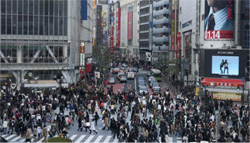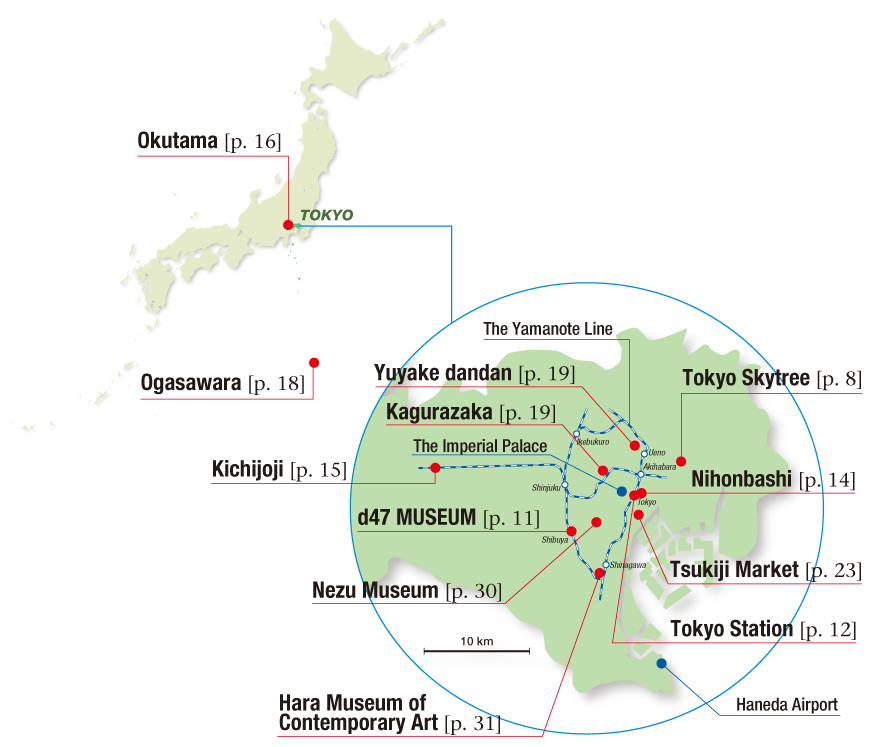Home > Highlighting JAPAN > Highlighting Japan OCTOBER 2012 > TOKYO: NEW PERSPECTIVES
Highlighting JAPAN
COVER STORY: TOKYO: NEW PERSPECTIVES
TOKYO: NEW PERSPECTIVES
Tokyo, Japan, is one of the world's major cities. Surprisingly, the city has a short history. In 1603, Tokugawa Ieyasu was appointed shogun, and established a shogunate government in Edo (former name for Tokyo), which became an economic and political center. For about 260 years afterward, the Tokugawa shogunate ruled Edo, which had a population of about 150,000 at first. Despite earthquakes and large fires, Edo grew, and had a population of 1 million by the start of the eighteenth century.
During the Meiji Restoration, which restored imperial rule to Japan in 1868, Edo was renamed Tokyo, and developed into a modern city. Tokyo was devastated by both the Great Kanto Earthquake in 1923 and World War II, but recovered from the damage each time, leading to further development. Today, Tokyo is one of the world's largest cities, with a population made up of 13 million Japanese and foreign nationals, and is visited by over 4 million foreign tourists every year. The Greater Tokyo Area, which encompasses the prefectures of Tokyo, Kanagawa, Chiba, and Saitama, has a population of over 30 million.
One characteristic that describes Tokyo is diversity. The combination of the latest trends, fashions, culture, and entertainment all make this a novel, urban city. Yet Tokyo is also an old city, rich in character. This month's Cover Story showcases the multifaceted city of Tokyo.

The constantly busy scramble crossing in front of Shibuya Station, Tokyo
"Tokyo Skytree is the new symbol of Tokyo and Japan, incorporating state-of-the-art technology and traditional design," says Dr. Yasushi Aoyama, a professor at Meiji University who joined the Tokyo Metropolitan Government in 1967 and served as Vice-Governor from 1999 to 2003. "Redevelopment projects are being advanced all over Tokyo as we move into the twenty-first century. You could say that Tokyo Skytree is one of a series of city development projects in Tokyo."
In recent years, large redevelopment projects have been moving forward in central Tokyo, including in Roppongi, Marunouchi and Shibuya. In addition, railroads, roadways, and other urban transportation systems are being upgraded and expanded, further increasing Tokyo's functionality and convenience. For example, in the heart of Tokyo there are more than 500 railway stations located within walking distance of most houses and offices. Tokyo International Airport (Haneda), which is 30 minutes away by train from the city center, started regular international flights in October 2010, making it more convenient to fly into the center of Tokyo from other countries.
To ensure the safety of the now enormous city of Tokyo, the Tokyo Metropolitan Government has implemented measures against natural disasters. These measures include making infrastructure such as roadways, waterways, and railroads earthquake resistant. Resident volunteers in Tokyo have established about 6,600 disaster-prevention organizations to help rescue victims or provide evacuation guidance during a disaster.
"Tokyo can be affected by natural disasters such as earthquakes and floods," says Professor Aoyama, "but it has a well-equipped social network to mitigate any damage caused by these disasters."
At the same time, Tokyo retains its great old traditions. Festivals large and small are held at Shinto shrines and parks almost every month, and are packed with people. Local shopping streets where you can buy food and household sundries can still be found close to any home in Tokyo. Shitamachi, literally meaning "downtown," the area where commoners lived in the Edo period, retains the atmosphere of those good old days and is now attracting attention as a tourist spot. It's always had a low crime rate.
Tokyo has made a bid to host the 2020 Olympics and Paralympics. In 1964, Japan became the first Asian country to host the Olympics, and showed the world that the country had rapidly achieved economic growth and recovered from the devastation of World War II.
"A Tokyo Olympics in 2020 would be extremely efficient, as the competition venues would all be within a 5-km radius, which is very rare for Olympics in recent years," says Professor Aoyama. "The Olympics would be the perfect opportunity to show to people worldwide that Tokyo is not only vast, but also safe and functional, a combination found in few other places in the world."
© 2009 Cabinet Office, Government of Japan







